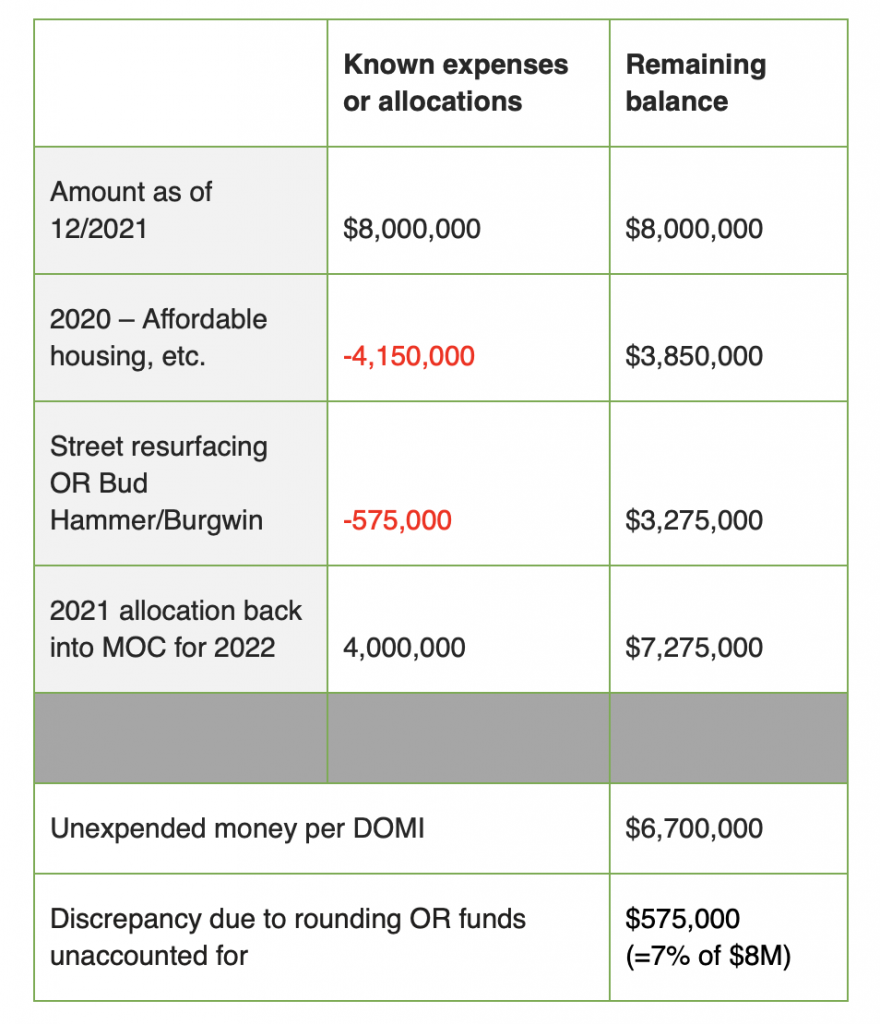When Mayor Ed Gainey announced an end to the Mon-Oakland Connector (MOC) shuttle road at the February 17 Greater Hazelwood community meeting, residents of affected communities applauded. They immediately requested basic improvements like safe street crossings, sidewalks and facilities for after-school programs. Officials offered no specific plans for redistributing MOC funds, but early reports focused on building a biking and walking trail that follows the same MOC route.
Five months after the MOC’s formal demise, as the bike/pedestrian trail project moves forward piece by piece, details on leftover MOC funds remain murky.
When we contacted Emily Bourne, communications specialist for Pittsburgh’s Department of Mobility and Infrastructure (DOMI), she said in a June 10 email that $6.7 million remains in the budget for the MOC, which she referred to as the Four Mile Run project.
“All of the funds are still in Four Mile Run named capital accounts,” Ms. Bourne wrote. “Any movement would require council action unless spent on something connected to the Four Mile Run project.”
However, Pittsburgh’s 2021 capital budget reported the project had $7.7 million in “unexpended/unencumbered prior year funds.” This figure aligns with the one provided to us by DOMI’s chief engineer Eric Setzler in late 2021. He said in a phone call, “I am seeing about $8 million [of City funds].”
Peering inside the magic bag
Some of the $1 million difference between the 2021 and 2022 figures can be explained by money that was diverted from the MOC budget.
In December 2020, City Council passed a budget amendment introduced by Councilman Corey O’Connor that moved $4.15 million out of the MOC. Those funds were divided among affordable housing programs, support for small businesses throughout Pittsburgh, and infrastructure improvements in Hazelwood. This should have left around $3.85 million in MOC funds.
But Ms. Bourne, when asked to confirm this, emailed that the diverted money was “not actual funds.”
“Had the budget been passed as introduced they would have been, but they were moved before the budget was adopted,” Ms. Bourne wrote. “There could have been other budget moves but nothing with actual obligated funds.”
“The only transfer was from December 2021 when Council moved $575,000 from Mon-Oakland ‘Four Mile Run’ to Street Resurfacing,” she added.
Indeed, Councilman O’Connor did introduce a budget amendment to remove $575,000 from the MOC funds. Of those, $550,000 went to new lights for Bud Hammer Field in Greenfield and $25,000 went to repair steps around Burgwin Field in Hazelwood.
It is unclear how the Bud Hammer Field lights and Burgwin Field steps are related to street resurfacing, and where the $4.15 million in the 2020 budget amendment originated if not from MOC funds. Also unexplained is the $4 million shown in the 2021 capital budget as going back into the MOC for 2022.
Asked to comment during a June 10 phone conversation, Councilman O’Connor said, “People at DOMI are not very intelligent. Whoever you were talking to does not know what they are talking about. We always make amendments before a budget is passed. Only the final draft of the budget matters.”
The 2022 capital budget contains no mention of the MOC. Councilman O’Connor explained this by saying the project “would not have to be listed in the capital budget if the funds have already been allocated,” and no new funding was being requested.
About 7% of the $8 million in the fund last December is unaccounted for by our reckoning. This could be a calculation error due to rounding, or it might actually be missing. But the funds still exist and are being spent on lights and steps, at the very least.

When will our money fund our solutions?
One fact has become plain over the past five months: The project and its funding will continue—minus Almono Partners’ proposed shuttles and the MOC name.
This slow-walked continuation of the project formerly known as the MOC raises concerns among members of MOC-affected communities. Residents and community organizations created Our Money, Our Solutions (OMOS), an alternative plan listing needed improvements that cost less than the MOC’s original $23 million budget.
Some OMOS priorities have come to pass, such as weekend service on the 93 bus line and Second Avenue/Irvine Street sidewalk repairs in progress. But critical items—such as traffic-calming measures on Hazelwood Avenue and lower Greenfield Avenue and those discussed at the February 17 meeting with Mayor Gainey—remain unaddressed. Why is bike trail infrastructure being prioritized over needs like these? City parks already have a dedicated source of revenue from taxpayers, while neglect has destroyed existing infrastructure in these communities over decades.
“We said at the February 17 meeting that we are looking to put in a request for money for repairs and improvements for Burgwin [Recreation Building],” Councilman O’Connor said, explaining those funds would not come from the MOC budget.
He added this is the first year City Council will have park tax funds to work with, and they have not yet finalized the process for distributing them.
Meanwhile, explorations into the mysteries of MOC funding continue. In a May 27 email responding to inquiries, City Controller Michael Lamb said his office will soon release their performance audit of several city departments. The audit included a review of the MOC that helped inform Mayor Gainey’s decision to end the project.

Recent Comments